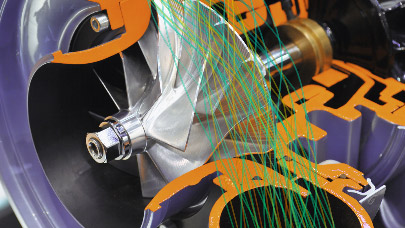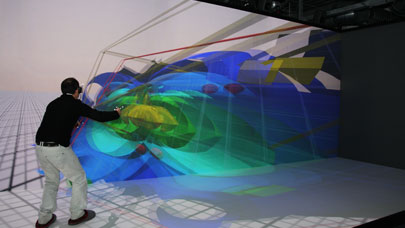Today, new features in simulation software combined with robust design practices and powerful high-performance computing environments enable engineers to predict turbomachinery performance and solve product design challenges faster than ever, with a high degree of confidence. Even the most complex design problems can be illuminated and addressed at an exacting level, as engineers strive to make ongoing improvements that balance efficiency gains with other critical design criteria. Following is a discussion of some of today’s most advanced turbomachinery design challenges – as well as strategies for answering them via engineering simulation.
Blade rows: new transient techniques
The fluid flow through blade rows affects many aspects of turbomachine performance, including work input or output, efficiency and operating range. For practical reasons, traditional analysis of blade rows has focused on steady-state performance. As good as it is, steady-state analysis fails to capture all the real-world intricacies of the flow as one row of blades rotates past another.
Specialized transient blade row methods (called “transformation methods”) accurately predict blade row performance over time, as well as over a range of real-world operating conditions. Irrespective of pitch ratio, these methods require modeling only one or two blades per row – yet still yield a full-wheel transient solution. Not only are problem-solving time and data storage space reduced dramatically, but smaller output files mean much faster post-processing of simulation results.
ANSYS has partnered with Siemens and other turbomachinery customers to apply these new transformation methods to a range of product design challenges. The results include dramatic improvements in simulation time and cost, creating a significant competitive advantage – while also ensuring that product integrity is maintained.
Aeromechanics: minimizing vibration and flutter
A catastrophic failure at the Sherburne County Generation Station in Minnesota in late 2011 caught the attention of the global turbomachinery industry. During an overspeed testing exercise, vibration was observed, then the blades broke; the 80-ton rotor was twisted, and metal components were thrown into an adjacent control room. While no one was harmed, this turbine failure is costing utility Xcel Energy more than $200 million and months of equipment downtime [3].
In public statements, Xcel noted that the vibration problem was a function of the original product design [4] – bringing new attention to the critical need to identify failure modes at the earliest possible design phase.
To help turbomachinery engineers meet vibration and flutter challenges, simulation software editors have developed new high-fidelity simulation techniques for aeromechanics studies. For instance, by coupling ANSYS Mechanical with ANSYS CFX transformation methods for transient blade row analysis, product development teams can simultaneously consider the aerodynamics and mechanics of the blade row. You then need support for the the close coupling of the multiple physics required to study the nuanced interactions of the fluid flow and bladed components.
Blade flutter can be accurately modeled via unsteady simulations for any range of nodal diameters using Fourier transformation methods. Forced response methods enable an assessment of stability that considers unsteady flows, predicted by modeling only one or two blades per row. High-speed, iterative solvers reduce processing time, while still ensuring the high fidelity and design robustness needed to deliver safe, reliable results in real-world product applications.
[3] Shaffner, D. – “Sherco Power Plant Repairs May Take 16 Months, Cost $200 Million”. Star Tribune, October 2, 2012.
[4] Shaffner, D. – “Failed Turbine Blades Caused Xcel Energy’s Generator Accident”. Star Tribune, April 15, 2013.
More around this topic...
In the same section
© HPC Today 2024 - All rights reserved.
Thank you for reading HPC Today.





























